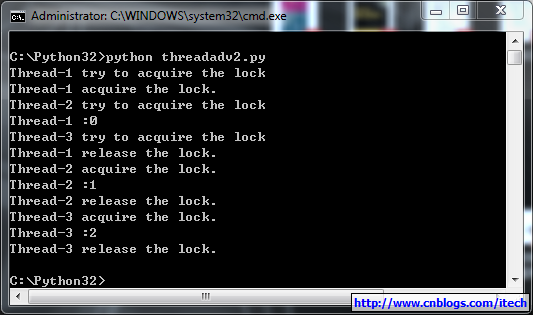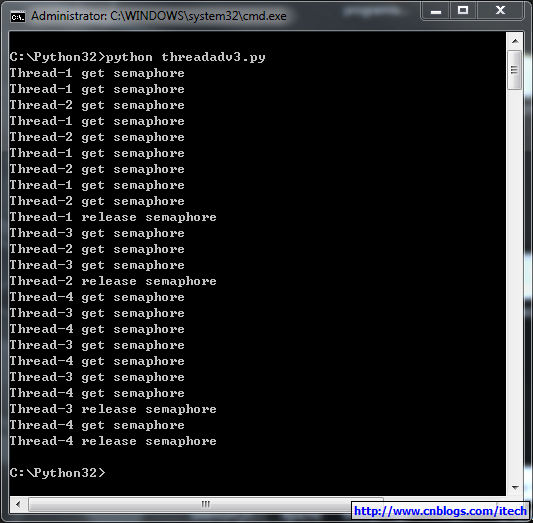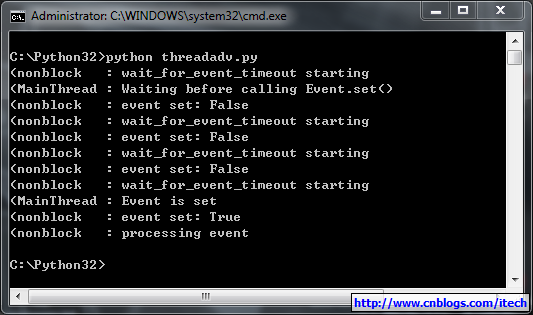Python多线程同步Lock、RLock、Semaphore、Event实例
一、多线程同步
由于CPython的python解释器在单线程模式下执行,所以导致python的多线程在很多的时候并不能很好地发挥多核cpu的资源。大部分情况都推荐使用多进程。
python的多线程的同步与其他语言基本相同,主要包含:
Lock & RLock :用来确保多线程多共享资源的访问。
Semaphore : 用来确保一定资源多线程访问时的上限,例如资源池。
Event : 是最简单的线程间通信的方式,一个线程可以发送信号,其他的线程接收到信号后执行操作。
二、实例
1)Lock & RLock
Lock对象的状态可以为locked和unlocked
使用acquire()设置为locked状态;
使用release()设置为unlocked状态。
如果当前的状态为unlocked,则acquire()会将状态改为locked然后立即返回。当状态为locked的时候,acquire()将被阻塞直到另一个线程中调用release()来将状态改为unlocked,然后acquire()才可以再次将状态置为locked。
Lock.acquire(blocking=True, timeout=-1),blocking参数表示是否阻塞当前线程等待,timeout表示阻塞时的等待时间 。如果成功地获得lock,则acquire()函数返回True,否则返回False,timeout超时时如果还没有获得lock仍然返回False。
实例:(确保只有一个线程可以访问共享资源)
import threading
import time
num = 0
lock = threading.Lock()
def func(st):
global num
print (threading.currentThread().getName() + ' try to acquire the lock')
if lock.acquire():
print (threading.currentThread().getName() + ' acquire the lock.' )
print (threading.currentThread().getName() +" :%s" % str(num) )
num += 1
time.sleep(st)
print (threading.currentThread().getName() + ' release the lock.' )
lock.release()
t1 = threading.Thread(target=func, args=(8,))
t2 = threading.Thread(target=func, args=(4,))
t3 = threading.Thread(target=func, args=(2,))
t1.start()
t2.start()
t3.start()
结果:

RLock与Lock的区别是:RLock中除了状态locked和unlocked外还记录了当前lock的owner和递归层数,使得RLock可以被同一个线程多次acquire()。
2)Semaphore
Semaphore管理一个内置的计数器,
每当调用acquire()时内置计数器-1;
调用release() 时内置计数器+1;
计数器不能小于0;当计数器为0时,acquire()将阻塞线程直到其他线程调用release()。
实例:(同时只有2个线程可以获得semaphore,即可以限制最大连接数为2):
import threading
import time
semaphore = threading.Semaphore(2)
def func():
if semaphore.acquire():
for i in range(5):
print (threading.currentThread().getName() + ' get semaphore')
semaphore.release()
print (threading.currentThread().getName() + ' release semaphore')
for i in range(4):
t1 = threading.Thread(target=func)
t1.start()
结果:

3) Event
Event内部包含了一个标志位,初始的时候为false。
可以使用使用set()来将其设置为true;
或者使用clear()将其从新设置为false;
可以使用is_set()来检查标志位的状态;
另一个最重要的函数就是wait(timeout=None),用来阻塞当前线程,直到event的内部标志位被设置为true或者timeout超时。如果内部标志位为true则wait()函数理解返回。
实例: (线程间相互通信)
import logging
import threading
import time
logging.basicConfig(level=logging.DEBUG,
format="(%(threadName)-10s : %(message)s",
)
def wait_for_event_timeout(e, t):
"""Wait t seconds and then timeout"""
while not e.isSet():
logging.debug("wait_for_event_timeout starting")
event_is_set = e.wait(t)
logging.debug("event set: %s" % event_is_set)
if event_is_set:
logging.debug("processing event")
else:
logging.debug("doing other work")
e = threading.Event()
t2 = threading.Thread(name="nonblock",
target=wait_for_event_timeout,args=(e, 2))
t2.start()
logging.debug("Waiting before calling Event.set()")
time.sleep(7)
e.set()
logging.debug("Event is set")
运行结果:

三、其他
1) 线程局部变量
线程局部变量的值是跟线程相关的,区别与全局的变量。使用非常简单如下:
mydata = threading.local()
mydata.x = 1
2)对Lock,semaphore,condition等使用with关键字代替手动调用acquire()和release()。

Hot AI Tools

Undresser.AI Undress
AI-powered app for creating realistic nude photos

AI Clothes Remover
Online AI tool for removing clothes from photos.

Undress AI Tool
Undress images for free

Clothoff.io
AI clothes remover

Video Face Swap
Swap faces in any video effortlessly with our completely free AI face swap tool!

Hot Article

Hot Tools

Notepad++7.3.1
Easy-to-use and free code editor

SublimeText3 Chinese version
Chinese version, very easy to use

Zend Studio 13.0.1
Powerful PHP integrated development environment

Dreamweaver CS6
Visual web development tools

SublimeText3 Mac version
God-level code editing software (SublimeText3)

Hot Topics
 1652
1652
 14
14
 1412
1412
 52
52
 1303
1303
 25
25
 1250
1250
 29
29
 1224
1224
 24
24
 PHP and Python: Different Paradigms Explained
Apr 18, 2025 am 12:26 AM
PHP and Python: Different Paradigms Explained
Apr 18, 2025 am 12:26 AM
PHP is mainly procedural programming, but also supports object-oriented programming (OOP); Python supports a variety of paradigms, including OOP, functional and procedural programming. PHP is suitable for web development, and Python is suitable for a variety of applications such as data analysis and machine learning.
 Choosing Between PHP and Python: A Guide
Apr 18, 2025 am 12:24 AM
Choosing Between PHP and Python: A Guide
Apr 18, 2025 am 12:24 AM
PHP is suitable for web development and rapid prototyping, and Python is suitable for data science and machine learning. 1.PHP is used for dynamic web development, with simple syntax and suitable for rapid development. 2. Python has concise syntax, is suitable for multiple fields, and has a strong library ecosystem.
 PHP and Python: A Deep Dive into Their History
Apr 18, 2025 am 12:25 AM
PHP and Python: A Deep Dive into Their History
Apr 18, 2025 am 12:25 AM
PHP originated in 1994 and was developed by RasmusLerdorf. It was originally used to track website visitors and gradually evolved into a server-side scripting language and was widely used in web development. Python was developed by Guidovan Rossum in the late 1980s and was first released in 1991. It emphasizes code readability and simplicity, and is suitable for scientific computing, data analysis and other fields.
 Python vs. JavaScript: The Learning Curve and Ease of Use
Apr 16, 2025 am 12:12 AM
Python vs. JavaScript: The Learning Curve and Ease of Use
Apr 16, 2025 am 12:12 AM
Python is more suitable for beginners, with a smooth learning curve and concise syntax; JavaScript is suitable for front-end development, with a steep learning curve and flexible syntax. 1. Python syntax is intuitive and suitable for data science and back-end development. 2. JavaScript is flexible and widely used in front-end and server-side programming.
 How to run sublime code python
Apr 16, 2025 am 08:48 AM
How to run sublime code python
Apr 16, 2025 am 08:48 AM
To run Python code in Sublime Text, you need to install the Python plug-in first, then create a .py file and write the code, and finally press Ctrl B to run the code, and the output will be displayed in the console.
 Can vs code run in Windows 8
Apr 15, 2025 pm 07:24 PM
Can vs code run in Windows 8
Apr 15, 2025 pm 07:24 PM
VS Code can run on Windows 8, but the experience may not be great. First make sure the system has been updated to the latest patch, then download the VS Code installation package that matches the system architecture and install it as prompted. After installation, be aware that some extensions may be incompatible with Windows 8 and need to look for alternative extensions or use newer Windows systems in a virtual machine. Install the necessary extensions to check whether they work properly. Although VS Code is feasible on Windows 8, it is recommended to upgrade to a newer Windows system for a better development experience and security.
 Where to write code in vscode
Apr 15, 2025 pm 09:54 PM
Where to write code in vscode
Apr 15, 2025 pm 09:54 PM
Writing code in Visual Studio Code (VSCode) is simple and easy to use. Just install VSCode, create a project, select a language, create a file, write code, save and run it. The advantages of VSCode include cross-platform, free and open source, powerful features, rich extensions, and lightweight and fast.
 How to run python with notepad
Apr 16, 2025 pm 07:33 PM
How to run python with notepad
Apr 16, 2025 pm 07:33 PM
Running Python code in Notepad requires the Python executable and NppExec plug-in to be installed. After installing Python and adding PATH to it, configure the command "python" and the parameter "{CURRENT_DIRECTORY}{FILE_NAME}" in the NppExec plug-in to run Python code in Notepad through the shortcut key "F6".




